“Criticism by politicians and politically motivated media attacks on individual judges, prosecutors and members of their families, and on judicial and prosecutorial institutions, have been a particular concern…”
European Commission (Jan. 22, 2014)
By Peter H. Frank and Roxana-Maria Gaina
(This article and database were amended on Nov. 27, 2014, to incorporate reader suggestions and reflect minor adjustments to some party affiliations. While some statistics changed, no significant differences resulted.)
The arrests keep coming. New allegations every week. Hundreds of politicians and the politically connected, from the powerful and famous to little-known officials, are being investigated, indicted, or imprisoned for money laundering, bribe-taking, influence peddling, abuse of power and more.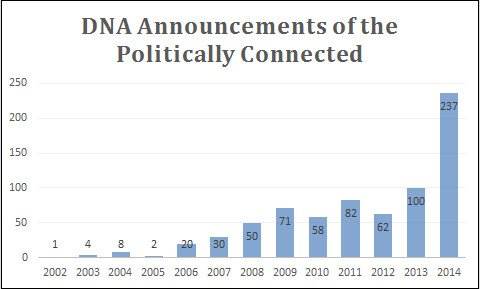
This year alone, more than 100 of Romania’s political elite have been indicted, including eight members of parliament, six county presidents, and 21 mayors, newly released data show. That does not include the more than 120 others who have been publicly accused by prosecutors, arrested, or announced as suspects, or the dozens more who were convicted.
In all sectors and industries, DNA investigations led to the indictment of 834 people through October this year, according to new figures, while more than 1000 people have been convicted.
Where the prosecutions will end and what lasting impact they will have is not yet clear. What is clear, though, is that much of the country’s political foundation is being ruptured, leading some to allege it is a conspiracy against certain political parties while others plainly claim it is a much-needed cleansing of systemic corruption that is destroying this country.
While an analysis of the available data cannot support either side’s claim with any certainty, it is clear from an extensive review of public data that one political party consistently accounts for the preponderance of corruption cases: the PSD.
CLICK HERE to download the excel file. CLICK HERE to view the pdf file.
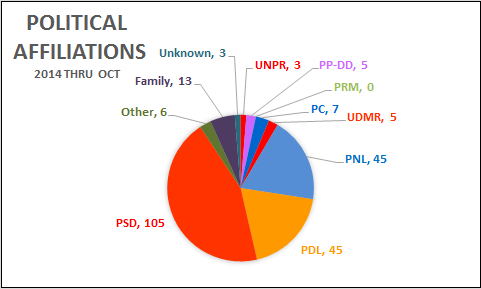
Number of politically connected individuals named as subjects of accusation, indictment, arrest or conviction by the DNA in the first 10 months of 2014 sorted by political affiliation.
In fact, in the first 10 months of this year, 44 percent of individuals who could be identified with clear political affiliations and were named by the Direcţia Naţională Anticorupţie (DNA) as subjects of accusation, indictment, arrest or conviction were affiliated with the PSD. In all, through October, 105 of the 237 individuals in this category were associated with the PSD. And its representation among those suspected, accused or arrested is increasing as the cases grow in complexity and scope. The PDL and PNL each accounted for 19 percent of the total.
A general impression that DNA activities involving politicians are increasing also proves correct. In the past three years alone, nearly 400 politicians and the politically connected have been the subject of prosecutors here while many of the most powerful and wealthy, seemingly untouchable a few years ago, have ended up in prison.
Indeed, this year’s spate of DNA announcements has arguably reached such a level that specific cases and names and cash amounts and crimes have created a foreground of details that can become increasingly blurred in the overwhelming landscape of corruption. And ironically, as the number of serious crimes being uncovered is on the rise, it often appears the media’s attention and the public’s interest merely slides the other way.
For that reason, we decided to look at all the indictments and investigations announced by the DNA since the agency’s founding in 2002, try to determine whether the people involved were politically connected, and if so, what might be deduced from an analysis of the data. In all, we reviewed nearly 4000 press releases in the DNA’s database and attempted to identify those individuals who had, at the time of announcement or previously, strong political associations.
[NOTE: The judgment that some people did or did not have political associations was not scientific. We could establish no firm and incontestable criteria. In other words, we do not claim that we used a pure measure, merely approximate based on our best judgment. We focused primarily on those we identified as politically involved and their families. There are also some names that appear more than once on this list. For statistical purposes, we included them each time and did not limit them to only one appearance in our calculations. There are also several politicians who have changed political parties, sometimes more than once. We have done our best to identify these individuals and we either used our best judgment as to which party to assign them or we placed them in the “Other” category. Also, we have attempted to proofread ourselves. But errors can occur and we encourage readers to bring any such errors to our immediate attention.]
To our knowledge, this is the only such database that exists, which we find regrettable. It is important to note that the details here cannot disclose any political motivations on the part of investigators, however much some parties might try. There is nothing self-evident except for the names and numbers. Importantly, there are no political conclusions that can be made – except by those who specialize more in propaganda than in facts.
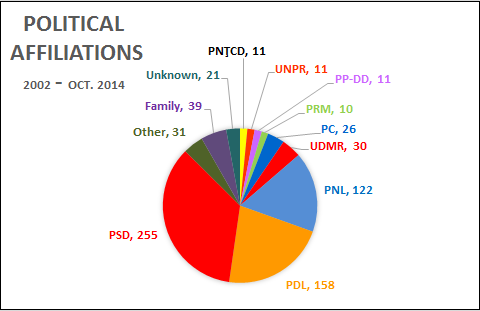
Number of politically connected individuals named as subjects in DNA press releases from its inception in 2002 through October 2014 sorted by political affiliation.
What the evidence can support, however, is the belief that this is clearly a critical time in the modern history of Romania, long considered one of the most corrupt nations in the European Union. And it increasingly appears that much of the economic success of Romania, and with it the country’s accession into the EU, was based on a foundation of endemic corruption from the time society here found its capitalistic footing in the 1990s through the booming first 10 years of the 21st century.
Because of the overwhelming involvement of the political class in these investigations and prosecutions, the battles, of course, have been used as political weapons by both sides. And because of such attempts [see, for example, an Oct. 22 headline in Jurnalul National, controlled by Dan Voiculescu, a PSD-friendly politician who is currently in prison: “DNA’s goal: Destroy the PSD”] it appeared to us as a self-evident necessity to try to measure such claims.
From outside, it is impossible to know and unfair to say whether the recent acceleration of prosecutions have had a political motive or whether they are a natural consequence of one investigation leading to others, or one conviction leading to more confessions.
Perhaps it’s a consequence of an increasing number of investigators being hired by the DNA. Or an increased aggressiveness that comes from a heightened morale as prosecutors begin to see more convictions and prison sentences meted out in recent years. Perhaps it also has to do with an increased expertise among investigators in uncovering and understanding complex conspiracies. And perhaps it’s an outcome of a 2010 provision that provides for leniency to people who confess and collaborate with prosecutors.
(For its part, the DNA insists that there are no political considerations in any of its investigations. It is, for example, why party affiliation is never mentioned in their press releases. It does not matter, a spokeswoman said.)
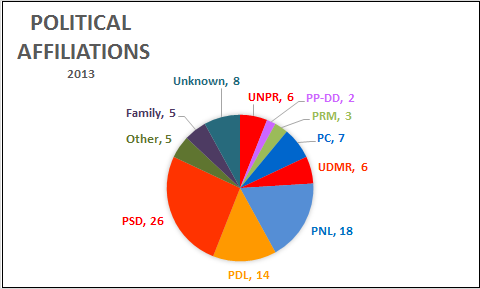
Number of politically connected individuals named as subjects in DNA press releases in 2013 sorted by political affiliation.
So whether it’s a political conspiracy or a much-needed cleansing cannot be determined merely by looking at the data. Yet, no matter the numbers, the extent of corruption is not likely to surprise Romanians. People in this country already know well the pervasiveness of corruption whether in politics, in education, in health care, and beyond. According to a survey in early 2013 by the European Commission, a full 93 percent of Romanians believe corruption here is either very or fairly widespread with two-thirds of respondents saying it had gotten worse in the previous three years.
And while some of those under attack by prosecutors would cast the DNA as a villain, much of the public here apparently trust in its actions. In fact, in Romania, where far fewer people than the European average trust the police or the courts to deal with corruption, more than three times the average trust their local anti-corruption agency, in this case the DNA. In fact, the DNA is trusted more here than any political body, the central bank, and yes, the media.
Even so, attacks on the DNA continue, giving rise to worries from the European Commission.
“Criticism by politicians and politically motivated media attacks on individual judges, prosecutors and members of their families, and on judicial and prosecutorial institutions, have been a particular concern …” an EC report stated earlier this year.
And recent attempts by the PSD-led government to sidestep certain procedures involving the DNA or Parliament’s passage a year ago of amendments that could effectively remove those in Parliament from laws against bribe taking, trading in influence and abuse of office – a move that was found unconstitutional in Romania and attracted heavy criticism from the EU – are also reasons for concern.
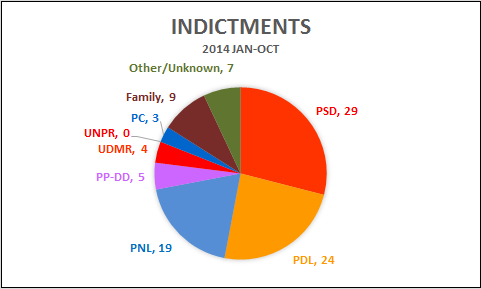
Number of politically connected individuals indicted by the DNA in the first 10 months of 2014 sorted by political affiliation.
In many ways, corruption, it seems, remains an accepted practice in business and politics. As another EC report concluded in January this year: “Whilst investigations, indictment and convictions are taking place, there is evidence that corruption is not always treated as a serious crime. Within the judicial system, the high percentage of suspended sentences seems to illustrate a reluctance by judges to carry through the consequences of a guilty verdict – in contradiction of the sentencing guidelines of the High Court itself.”
(In the first 288 days of last year, the report said, there were 853 defendants convicted in cases brought by the DNA. Nearly 80 percent of them were given suspended sentences.)
Then there is the money – the reason for most of the crimes to begin with. Perhaps more than prison, the threat of losing one’s wealth can potentially be the strongest deterrent available. But not here.
“Another important issue in this respect will be to improve track records in confiscation of assets and asset recovery. Extended confiscation, to allow for assets to be confiscated from relatives, still remains a scant and relatively rarely-used procedure,” the report said.
“This reluctance is underlined when Romanian politicians make statements which express sympathy for those convicted of corruption.”
In all, less than 10 percent of court-specified damages are recovered by the Romanian Asset Recovery Office, the EC report stated, adding that “it seems that the public authorities responsible for recovering these damages only rarely pursue the cases.”
While these additional issues deserve more attention and creative ways of bringing them alive to the public, they are not the primary concern of this database.
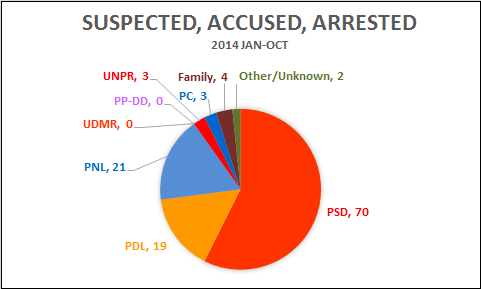
Number of politically connected individuals named by the DNA as suspected, accused, or arrested for alleged criminal activity in the first 10 months of 2014.
It is our desire that this spreadsheet is a beginning, not a final document. It has been posted less to answer questions than to provide details to the landscape. It is our belief that it is long overdue for this publicly available information to be compiled in one place to help shed light on the environment of corruption in this country. We hope it leads to someone providing periodic updates, more informative stories, more balanced articles, and more detailed studies by the press at large. We know it might be purposefully misconstrued by those with an obvious, or not-so-obvious, agenda, but we have no control over that. Only solid and responsible journalism can counter those attempts.
Given the political atmosphere in this country, other salient facts include:
• Of the 725 individuals we identified as politically connected and subjects of the DNA and named in their press releases since the agency’s founding in 2002, more than 95 percent occurred since Oct. 2, 2006 when Laura Codruta Kovesi became general prosecutor.
• Of all politically related announcements since 2002, 35 percent involved people with PSD affiliations, 22 percent with PDL and 17 percent with the PNL.
• The number of politically related persons who were subjects of DNA announcements has increased significantly in the past two years, climbing roughly 50 percent from previous years to 100 individuals in 2013 and to 237 in just the first 10 months of this year.
• In 2013, the percentage of PSD affiliated persons who were named in DNA press releases was 26 percent of the total compared with 18 percent for the PNL and 14 percent for the PDL.
• Of those individuals named more specifically as suspects or were accused or arrested in the first 10 months this year, 57 percent were associated with the PSD, while the PNL accounted for only 17 percent and the PDL for 16 percent. Much of the increase in PSD representation stemmed from the presence of several large cases.
• Of those individuals indicted through October this year, PSD-associated individuals accounted for 29 percent while the PDL represented 24 percent and the PNL was at 19 percent.
• Importantly, much of the overall increase in the number of people named in 2014 came as the scope and apparent complexities of the investigations also increased. Nearly 40 percent more individuals were involved on average in each of the cases listed on this database than in 2013.
###


24 Comments
This is a very useful compilation. Kudos to Roxana Maria Gaina and everyone else involved!
I think it would be interesting to see a breakdown of percentages which takes into consideration the number of all politicians in position of power from each party at the time. This could help answer important questions, such as:
– Are all parties uniformly corrupt?
– Do parties get more corrupt as they get bigger?
– etc.
Again, thanks for doing this and keep up the good work!
This is Indeed a much needed approach to political corruption, and you’ve succeeded in keeping it rather objective. I agree with the questions raised by Scribu. I believe one should stress more the structural effect that lies beneath the number of accusations/arrests/indictments per party of affiliation. What proportion is there between the total number of individuals politically affiliated to a party and the number of those who were subject to DNA actions? Isn’t PSD the party with the largest number of members, which would explain the highest total of corruption cases?
And now, thank you, too. Those are very good questions, a bit tough to pursue, but very good. For instance, how to define political affiliation, calibrate over time for changes in numbers adjusting perhaps for the party’s relative position of power, discern whether corruption is more cause or effect of party size, and ultimately whether the percentage is proportional to the corruption within the society at large, once you define corruption. But it all is worth pursuing and certainly would make for a great dinner party. The issue’s not going away. If nothing else, you two have started a terrific conversation, one that I might bow out of (as I have no expertise), but I look forward to more.
Thank you. Firstly, just to be clear, there was no one else involved. Roxana and I worked together on this and she alone prepared this database. Your kudos to her are well-deserved indeed. Secondly, you are right. Those are excellent story ideas. Our hope is that there will be many stories that stem from this information, new ideas, new ways of looking at the data, new compelling articles this might inspire, new projects in database journalism this might provoke.
have you counted PMP politicians too? like deputy Florin Popescu? is he part of ‘Others’?
As mentioned, individuals who have changed parties was one of the toughest challenges for us. He is listed here, but as a member of his previous party, the PDL. We will look to amend the chart soon to correct any errors, but we do not expect to update it on a continual basis.
Very powerful insights, but please have in mind that the color associated with the parties might be confusing. PSD is red (color code: Russia Red) PNL (the liberal party) is blue or yellow, PDL is orange.
Yes, good point. You have discerned, perhaps, that technology is not my strongest area of expertise. Once I figure out how to change colors in the pie, I will do that.
Peter your blog is great. I linked to it here. http://pvewood.blogspot.ro/2014/11/political-corruption-in-romania-analysed.html
I shall reread your post and comment when I have had time to think it through. Paul Wood
Thanks, Paul. Thanks very much.
I also shared it on Facebook.
Excellent job, congratulations!
But article appeared too late, before the tour one of the presidential elections would have helped.The lady who founded DNA ,Monica Macovei ,was in the race.
I want to point out that there’s a problem in the pdf and excell files. At the harm category there seems to be a confussion between ROL(the old romanian curency) and RON(the new one). For instance, the harm caused by Mureşan Ioan Avram would be a rough 6.6 billion euros.
Thank you. We’ll be sure to note this when we update the file.
thank you for the data. Could you tell how you obtained these data. Newspapers, websites?
Regarding the database, most of the data is from DNA press releases, which are available on their website, with party affiliations and some minor additional information from various online sources.
[…] Source: Political Corruption in Romania: The DNA Database […]
[…] Source: Political Corruption in Romania: The DNA Database […]
[…] De citit: Peter H. Frank și Roxana-Maria Găina: Political Corruption in Romania: The DNA Database […]
[…] De citit: Peter H. Frank și Roxana-Maria Găina:Political Corruption in Romania: The DNA Database […]
[…] De citit: Peter H. Frank și Roxana-Maria Găina: Political Corruption in Romania: The DNA Database […]
Excellent idea, congratulations for your work, much respect! If you don’t mind, I would use the data to update a similar endeavor I have been working on, the Romanian coruptopedia as I call it – http://www.maricorupti.ro. It is still a proof of concept, but in time I hope it will become a go-to destination for checking out who’s out and who’s in.
Thanks very much. The intent of presenting the database the way that I did was to place it into the public sphere for any appropriate use, so you are free to use it. Good luck with your project.
[…] Comunicate DNA privind persoane cu conexiuni politice. Sursa: Peter Frank […]